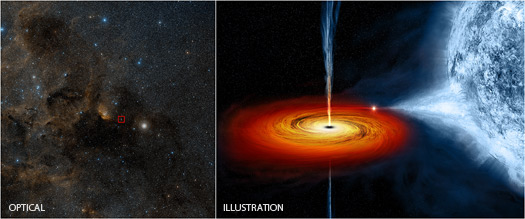- Cygnus X-1 is a black hole about 15 times the mass of the Sun in orbit with a massive blue companion star.
- Astronomers used several telescopes including Chandra to study Cygnus X-1.
- The combined data have revealed the spin, mass, and distance of this black hole more precisely than ever before.
- Stephen Hawking lost a bet – originally placed in 1974 — that Cygnus X-1 did not contain a black hole.
On the left, an optical image from the Digitized Sky Survey shows Cygnus X-1, outlined in a red box. Cygnus X-1 is located near large active regions of star formation in the Milky Way, as seen in this image that spans some 700 light years across. An artist’s illustration on the right depicts what astronomers think is happening within the Cygnus X-1 system. Cygnus X-1 is a so-called stellar-mass black hole, a class of black holes that comes from the collapse of a massive star. The black hole pulls material from a massive, blue companion star toward it. This material forms a disk (shown in red and orange) that rotates around the black hole before falling into it or being redirected away from the black hole in the form of powerful jets.
A trio of papers with data from radio, optical and X-ray telescopes, including NASA’s Chandra X-ray Observatory, has revealed new details about the birth of this famous black hole that took place millions of years ago. Using X-ray data from Chandra, the Rossi X-ray Timing Explorer, and the Advanced Satellite for Cosmology and Astrophysics, scientists were able to determine the spin of Cygnus X-1 with unprecedented accuracy, showing that the black hole is spinning at very close to its maximum rate. Its event horizon — the point of no return for material falling towards a black hole — is spinning around more than 800 times a second.
Using optical observations of the companion star and its motion around its unseen companion, the team also made the most precise determination ever for the mass of Cygnus X-1, of 14.8 times the mass of the Sun. It was likely to have been almost this massive at birth, because of lack of time for it to grow appreciably.
The researchers also announced that they have made the most accurate distance estimate yet of Cygnus X-1 using the National Radio Observatory’s Very Long Baseline Array (VLBA). The new distance is about 6,070 light years from Earth. This accurate distance was a crucial ingredient for making the precise mass and spin determinations.
|
|||||||||||||||||||||






